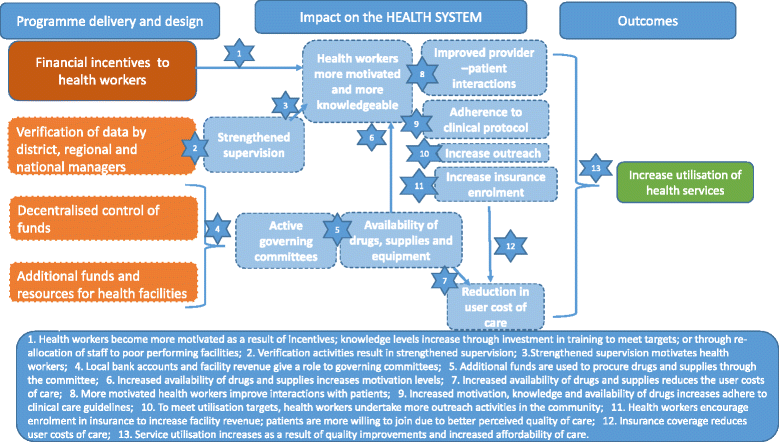Understanding causal pathways within health systems policy evaluation through mediation analysis: an application to payment for performance (P4P) in Tanzania
- PMID: 28148305
- PMCID: PMC5288944
- DOI: 10.1186/s13012-016-0540-1
Understanding causal pathways within health systems policy evaluation through mediation analysis: an application to payment for performance (P4P) in Tanzania
Abstract
Background: The evaluation of payment for performance (P4P) programmes has focused mainly on understanding contributions to health service coverage, without unpacking causal mechanisms. The overall aim of the paper is to test the causal pathways through which P4P schemes may (or may not) influence maternal care outcomes.
Methods: We used data from an evaluation of a P4P programme in Tanzania. Data were collected from a sample of 3000 women who delivered in the 12 months prior to interview and 200 health workers at 150 health facilities from seven intervention and four comparison districts in Tanzania in January 2012 and in February 2013. We applied causal mediation analysis using a linear structural equation model to identify direct and indirect effects of P4P on institutional delivery rates and on the uptake of two doses of an antimalarial drug during pregnancy. We first ran a series of linear difference-in-difference regression models to test the effect of P4P on potential mediators, which we then included in a linear difference-in-difference model evaluating the impact of P4P on the outcome. We tested the robustness of our results to unmeasured confounding using semi-parametric methods.
Results: P4P reduced the probability of women paying for delivery care (-4.5 percentage points) which mediates the total effect of P4P on institutional deliveries (by 48%) and on deliveries in a public health facility (by 78%). P4P reduced the stock-out rate for some essential drugs, specifically oxytocin (-36 percentage points), which mediated the total effect of P4P on institutional deliveries (by 22%) and deliveries in a public health facility (by 30%). P4P increased kindness at delivery (5 percentage points), which mediated the effect of P4P on institutional deliveries (by 48%) and on deliveries in a public health facility (by 49%). P4P increased the likelihood of supervision visits taking place within the last 90 days (18 percentage points), which mediated 15% of the total P4P effect on the uptake of two antimalarial doses during antenatal care (IPT2). Kindness during deliveries and the probability of paying out of pocket for delivery care were the mediators most robust to unmeasured confounding.
Conclusions: The effect of P4P on institutional deliveries is mediated by financing and human resources factors, while uptake of antimalarials in pregnancy is mediated by governance factors. Further research is required to explore additional and more complex causal pathways.
Keywords: Health financing; Health governance; Human resources; Maternal care; Mediation analysis; Pay for performance; Policy evaluation; Tanzania.
Figures
References
-
- Ludwig J, Kling JR, Mullainathan S. Mechanism experiments and policy evaluations. J Econ Perspect. 2011;25(3):17–38. doi: 10.1257/jep.25.3.17. - DOI
Publication types
MeSH terms
Substances
LinkOut - more resources
Full Text Sources
Other Literature Sources
Miscellaneous


